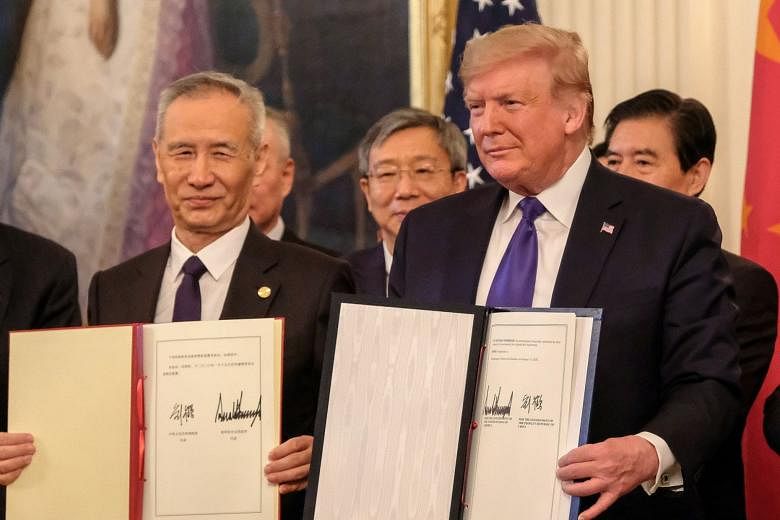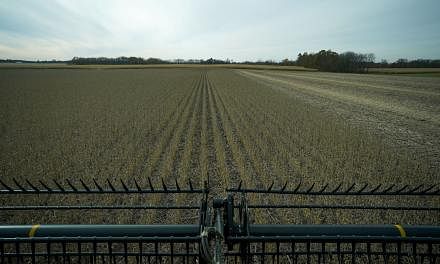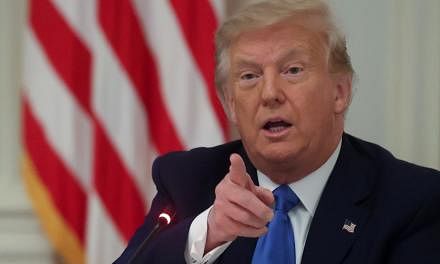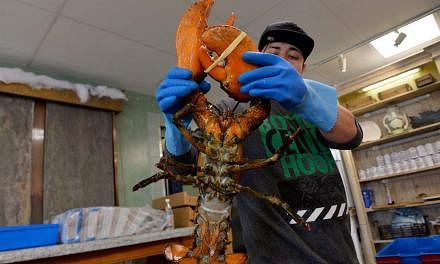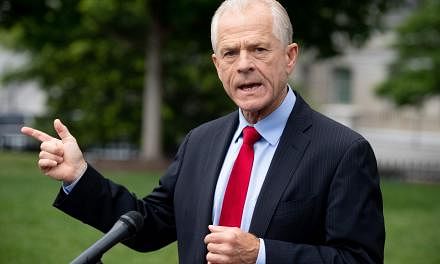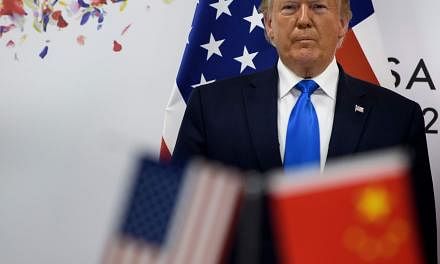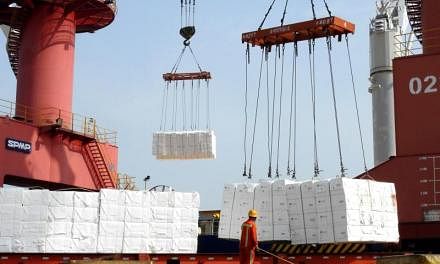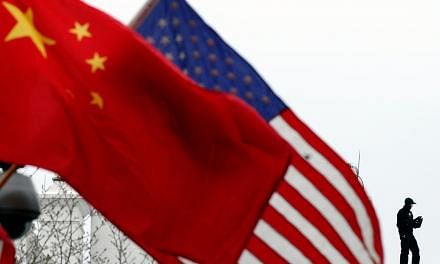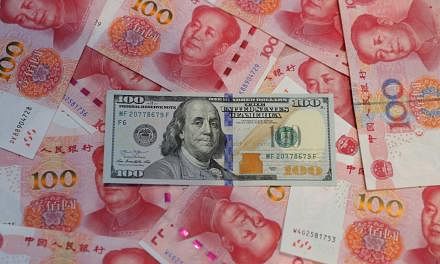WASHINGTON (REUTERS) - The United States and China signed an initial trade deal on Wednesday (Jan 15) that will roll back some tariffs and boost Chinese purchases of US products, defusing an 18-month row between the world's two largest economies but leaving a number of sore spots unresolved.
Beijing and Washington touted the "Phase One" agreement as a step forward after months of start-stop talks, and investors greeted the news with relief.
But there also was scepticism the US-Sino trade relationship was now firmly on the mend.
The deal fails to address structural economic issues that led to the trade conflict, does not fully eliminate the tariffs that have slowed the global economy, and sets hard-to-achieve purchase targets, analysts and industry leaders said.
While acknowledging the need for further negotiations with China to solve a host of other problems, US President Donald Trump hailed the agreement as a win for the US economy and his administration's trade policies.
"Together, we are righting the wrongs of the past and delivering a future of economic justice and security for American workers, farmers and families," Trump said in rambling remarks at the White House alongside US and Chinese officials.
Chinese Vice-Premier Liu He read a letter from President Xi Jinping in which the Chinese leader praised the deal as a sign the two countries could resolve their differences with dialogue.
The centrepiece of the deal is a pledge by China to purchase at least an additional US$200 billion (S$270 billion) worth of US farm products and other goods and services over two years, over a baseline of US$186 billion in purchases in 2017, the White House said.
Commitments include US$54 billion in additional energy purchases, US$78 billion in additional manufacturing purchases, US$32 billion more in farm products, and US$38 billion in services, according to a deal document released by the White House.
Liu said Chinese companies would buy US$40 billion in US agricultural products annually over the next two years "based on market conditions."
Beijing had balked at committing to buy set amounts of US farm goods earlier, and has inked new soybean contracts with Brazil since the trade war started.
Key world stock market indexes climbed to new records on hopes the deal would reduce tensions, but oil prices slid on doubts the pact will spur world economic growth and boost crude demand.
Soybean futures, which traded 0.4 per cent lower throughout much of the deal signing ceremony, sank even further after Liu's remarks, a sign that farmers and traders were dubious about the purchase goals.
The deal doesn't end retaliatory tariffs on American farm exports, makes farmers "increasingly reliant" on Chinese state-controlled purchases, and doesn't address "big structural changes," Michelle Erickson-Jones, a wheat farmer and spokeswoman for Farmers for Free Trade, said in a statement.
Trump and his economic advisers had pledged to attack Beijing's long-standing practice of propping up state-owned companies, and flooding international markets with low-priced goods as the trade war heated up.
Although the deal could be a boost to US farmers, automakers and heavy equipment manufacturers, some analysts question China's ability to divert imports from other trading partners to the United States.
"I find a radical shift in Chinese spending unlikely. I have low expectations for meeting stated goals," said Jim Paulsen, chief investment strategist at Leuthold Group in Minneapolis. "But I do think the whole negotiation has moved the football forward for both the US and China."
Trump, who has embraced an "America First" policy aimed at rebalancing global trade in favour of US companies and workers, said China had pledged action to confront the problem of pirated or counterfeited goods, and that the Phase 1 deal included strong protection of intellectual property rights.
Earlier, top White House economic adviser Larry Kudlow told Fox News the agreement would add 0.5 percentage point to US gross domestic product growth in both 2020 and 2021.
Aviation industry sources said Boeing was expected to win a major order for wide-body jets from China, including its 787 or 777-9 models, or a mixture of both. Such a deal could ease pressure on the 787 Dreamliner, which has suffered from a broad downturn in demand for large jets, forcing the planemaker to trim production late last year.
TARIFFS TO STAY
The Phase One deal, reached in December, cancelled planned US tariffs on Chinese-made cellphones, toys and laptop computers and halved the tariff rate to 7.5 per cent on about US$120 billion worth of other Chinese goods, including flat panel televisions, Bluetooth headphones and footwear.
But it will leave in place 25 per cent tariffs on a vast, US$250 billion array of Chinese industrial goods and components used by US manufacturers, and China's retaliatory tariffs on over US$100 billion in US goods.
Market turmoil and reduced investment tied to the trade war cut global growth in 2019 to its lowest rate since the 2008-2009 financial crisis, the International Monetary Fund said in October.
Tariffs on Chinese imports have cost US companies US$46 billion. Evidence is mounting that tariffs have raised input costs for US manufacturers, eroding their competitiveness.
Diesel engine maker Cummins said on Tuesday that the deal will leave it paying US$150 million in tariffs for engines and castings that it produces in China. It urged the parties to take steps to eliminate all the tariffs.
Trump, who has been touting the Phase 1 deal as a pillar of his 2020 re-election campaign, said he would agree to remove the remaining tariffs once the two sides had negotiated a "Phase Two"agreement. He added that those negotiations would start soon.
"They will all come off as soon as we finish Phase Two," said Trump, who added that he would visit China in the not-too-distant future.
